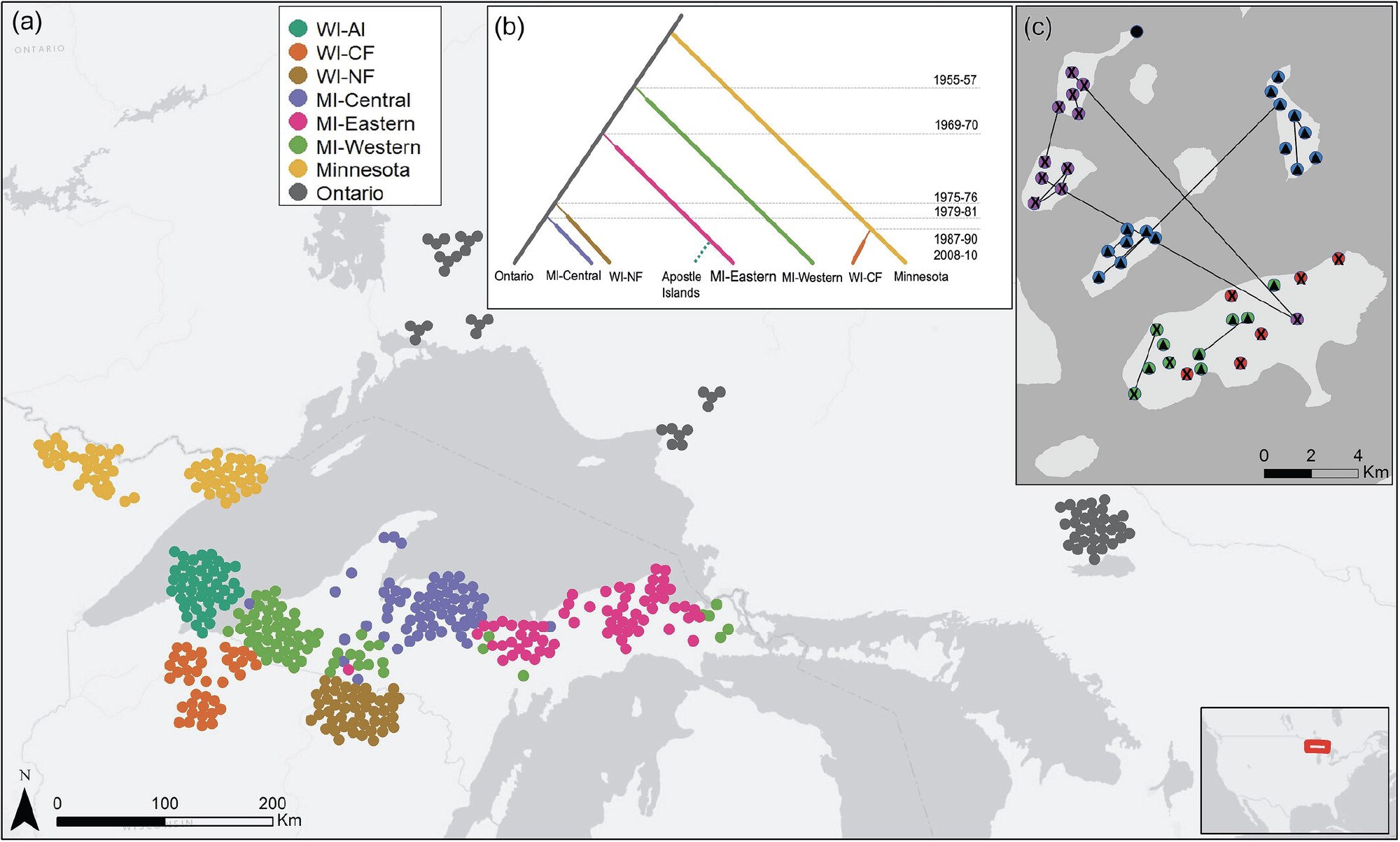Panmictic populations are increasingly fragmented by anthropogenic land use and climate change. Accordingly, the metapopulation concept is becoming increasingly applicable to a growing number of species, globally. Historically, island systems have served as natural laboratories for understanding meta-population dynamics because populations are naturally, demographically isolated. Archipelagos are particularly ideal systems for studying the effects of demographic isolation and connectivity due to their natural spatial configuration, characterized by a series of usable patches at varying distances separated by an unusable matrix. The Apostle Islands of Wisconsin are an archipelago of 23 islands in southern Lake Superior hosting a broad suite of carnivores. The Pauli Lab is currently studying two carnivores with distinct dispersal capacities – the American black bear (Ursus Americanus) and the American marten (Martes Americanus) – to untangle how warming winters, resource availability, and habitat quality interact to shape population persistence.
Black bears and martens are clan animals culturally significant to the Ojibwe. The Apostle Islands are the ancestral land of the Ojibwe Nation, and the Red Cliff and Bad River Reservations are located on the adjacent mainland.
Black Bears
The Pauli Lab is conducting a non-invasive genetic project to investigate population connectivity and vital rates of black bears to determine population trajectories and viability on the islands and adjacent Red Cliff reservation. We are interested in how black bears may function as a meta-population, and how small, relatively isolated populations of bears persist. Understanding vital rates of black bears including birth and death rates, temporary immigration and emigration, and connectivity on four of the Apostle Islands as well as Red Cliff will serve to uncover important drivers of population dynamics. We are also interested in how habitat quality, resource availability, degree of island isolation, and quality of water crossings may affect local bear abundance. This information is essential for furthering our understanding of how large- bodied carnivore persist in fragmented systems and for the Red Cliff and the National Lakeshore to effectively manage black bear populations.
Martens
The Pauli lab is also investigating the role of the apostle islands archipelago in the recovery of American martens to northern Wisconsin. As the state’s only endangered mammal, the unexpected observation of a marten on Oak Island in 2010 sparked an exciting new research program with the goals of identifying marten abundance, occupancy, survival, recolonization potential, population trajectories and recovery limitations for both the island populations and their neighbors on the mainland. Martens have since been observed on 10 of the 23 islands, and using non-invasive genetic sampling we determined that the Apostle Island population is large, growing, and acting as a source of individuals back to the mainland. Marten dispersal between the islands, and from the islands to the mainland, is restricted to periods of winter ice cover on Lake Superior. Accordingly, the role of the Apostle islands in the recovery of mainland populations is contingent on the continued formation of lake ice. While this archipelagic population is viable and supports the recovery of martens to the state of Wisconsin, viability of overall meta-population remains uncertain. We aim to further define the conditions that have facilitated population persistence and consistent population growth of martens.

Map of American marten (Martes americana) samples collected from the regional recovery network in the Great Lakes Region showing the locations of sampled individuals (a). An example diagram of the tree topology used to test alternate colonization scenarios with dates of historical translocation events (b). Different colors represent unique genetic clusters from K = 4. Black lines represent first-order relatives (parent-offspring or full-sibships) consistent at 95% confidence (c). See Smith et al., 2022 Eco. Apps.
We are currently working to quantify prey availability and proportional dietary components of martens through small mammal sampling and stable isotope analyses of marten hair. Second, we will quantify marten movement and energetic requirements using GPS telemetry and accelerometry. Third, we will determine marten perception of risk via giving-up-density experiments. And finally, we will use remotely sensed lidar data to determine how marten energetics are modulated by habitat quality and structural complexity of the islands. By defining these energetic components within this archipelagic refugia, and comparing them to that of the mainland populations, we can determine what is ultimately limiting the recovery of martens in Wisconsin. This will further our understanding of carnivore persistence in a changing environment and the potential role of archipelagic refugia in the recovery of a species.
Project Members: Matt Smith, Monica Cooper, Bijit Khadka, Carly Scott
This project is in collaboration with the Red Cliff Band of Ojibwe, the Apostle Islands National Lakeshore, and the Great Lakes Indian Fish and Wildlife Commission, the Wisconsin Department of Natural Resources, the National Park Service, and the USDA.
